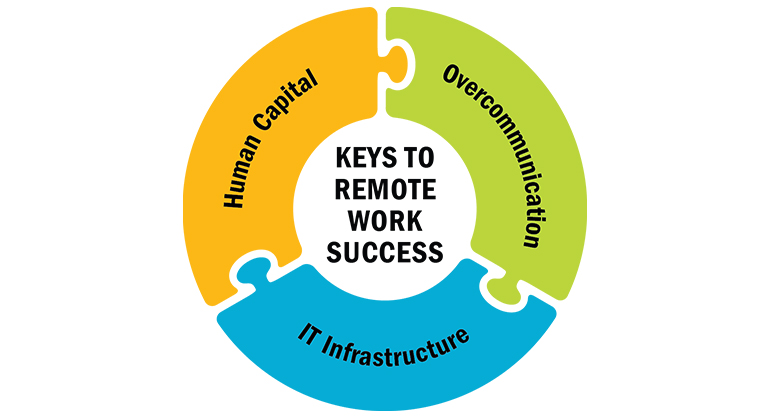 06-10-2020
06-10-2020
How workforces can thrive working from home, even during a pandemic
The COVID-19 pandemic has transformed the typical 9-to-5 for millions of Americans, as teams have abandoned traditional office spaces to social distance in home workspaces. And it’s likely this shift is here to stay. A May Gartner study projects that post-pandemic, working from home will remain in high demand, with about 48% of the workforce working remotely, compared to 30% working remotely pre-pandemic.
While some employees were remote work-ready with dedicated workspaces when the pandemic began, others rushed to cobble together monitors and office equipment into what square footage they were able to find in their kitchens. A wide range of needs requires employers be ready to deploy an equally wide range of empowering and supporting solutions.
FlexJobs recognizes SAIC as one of the best employers for remote work in the country. We have made working from home easier for years — well before the pandemic. Here are three keys we think employers need to adopt to make remote work successful during and after the pandemic.
Human capital
With miles — not feet — now separating team members, team leaders and project managers must take deliberate action to manage human capital, such as regular check-ins, just to affirm an employee’s emotions. It is important to make sure employees understand the company is there for them to provide resources to help them cope with the stresses related to the pandemic.
At SAIC, to empower our employees, we launched the Coronavirus Coping Corner, an internal resource our cognitive performance coaches created to provide various coping mechanisms to skillfully approach stress management, attention management, sleep optimization, and cognitive restructuring.
RELATED: SAIC shares the 5 mental performance strategies from our Coronavirus Coping Corner
“Focus on being in the present moment and not allowing your mind to wander to the ‘what if’s,’” reads one tip on mindfulness.
“This tool helps guide a lot of the day-to-day activities they can do to manage the stress associated with this environment and scenario we're in right now,” Onstott said.
Our cognitive performance coaches can also help our customers’ employees manage their stress, direct their focus, and raise their performance through our Human Performance Edge Training solution. This provides tools and coaching to teach employees how to adapt to the rigors of operating in a global pandemic and manage their mental state.
Learn how to improve your company's human capital
Confirming communication
One of the most common issues SAIC now faces is an explosion in scheduled meetings.
“It’s to the point that it’s just wall-to-wall meetings,” Onstott said. “I think it’s because you don’t have the random hallway conversations that can happen and you can’t linger after meetings to talk to someone.”
But fewer in-person meetings means body language and other nonverbal communication signals are often removed from conversations. Onstott recommends taking the time to overcommunicate intentions with team members and make fewer assumptions.
And to fight the onslaught of video calls, Onstott suggests what he deems a “culture hack”: stop scheduling so many meetings and instead find alternative means of communication, like texting and calling.
“I’m hoping that frees up time … so we can get back to having a little bit more flexibility in how we interact on a day-to-day basis,” he said.
Always-available IT infrastructure
SAIC had a strong telework support infrastructure before the pandemic, which simplified moving to remote work. “For us, it wasn’t a big deal when we basically flipped over to where everybody is teleworking, because we had made those investments in the infrastructure part,” Onstott said.
But we found that a lot of government customers were not as prepared for mass teleworking. Remote workforces create greater cybersecurity threats, and overuse of VPNs put pressure on bandwidths and diminish workforce productivity. A well-established IT infrastructure is key to supporting remote workers.
“There’s a lot of need right now across the government to help them update their infrastructures to support remote work,” Onstott said.
To ease the transition, we launched our Virtual Infrastructure Engineering Services and Help Desk solution. After evaluating a customer’s current IT state, we assist in the deployment, adoption, and optimization of secure cloud-based virtual desktops and help desks. This supports geographically distributed workforces and ensures business continuity.
We have already deployed this solution to multiple military and Department of Defense customers to sustain their productivity.
Learn how to improve your IT infrastructure
The new normal of remote work will come with obstacles that can impact productivity, reduce team cohesion, and degrade IT ecosystems. Our innovative solutions enable our customers to hurdle these challenges and successfully meet their mission needs.




